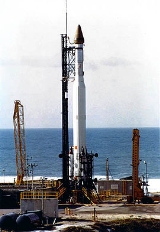
Thorad-Agena
Encyclopedia
The Thorad-Agena was an American
expendable launch system
, derived from the Thor and Delta rocket
s. The first stage of the rocket was the stretched variant of the Thor which had been developed for the Delta programme. The second stage was the Agena-D
, which had already been used in conjunction with the standard configuration Thor, as the Thor-Agena
. Three Castor rocket
s would be used as boosters
. Forty-three were launched between 1966 and 1972, of which two failed, and one delivered its satellite into an incorrect, but still usable orbit. Most launches carried Corona
(KeyHole) reconnaissance satellite
s, particularly spacecraft of the KH-4 series, however some scientific and technology development satellites were also flown, mostly towards the end of the programme.
The Thorad-Agena was flown in two different configurations, the SLV-2G, and the SLV-2H. These differed in that the SLV-2G used Castor 1 strap-on boosters, whereas the 2H used Castor 2s.
United States
The United States of America is a federal constitutional republic comprising fifty states and a federal district...
expendable launch system
Expendable launch system
An expendable launch system is a launch system that uses an expendable launch vehicle to carry a payload into space. The vehicles used in expendable launch systems are designed to be used only once , and their components are not recovered for re-use after launch...
, derived from the Thor and Delta rocket
Rocket
A rocket is a missile, spacecraft, aircraft or other vehicle which obtains thrust from a rocket engine. In all rockets, the exhaust is formed entirely from propellants carried within the rocket before use. Rocket engines work by action and reaction...
s. The first stage of the rocket was the stretched variant of the Thor which had been developed for the Delta programme. The second stage was the Agena-D
RM-81 Agena
The RM-81 Agena was an American rocket upper stage and satellite support bus which was developed by Lockheed initially for the canceled WS-117L reconnaissance satellite program...
, which had already been used in conjunction with the standard configuration Thor, as the Thor-Agena
Thor-Agena
Thor-Agena was a series of orbital launch vehicles. The rockets used Thor first stages and Agena second stages. They are thus cousins of the more famous Thor-Deltas, which founded the Delta rocket family. The first attempted launch of a Thor-Agena was in January 1959...
. Three Castor rocket
Castor (rocket stage)
The Castor family of solid-fuel rocket stages and boosters were built by Thiokol and used on a variety of launch vehicles. They were initially developed as the second stage motor of the Scout rocket...
s would be used as boosters
Solid rocket booster
Solid rocket boosters or Solid Rocket Motors, SRM, are used to provide thrust in spacecraft launches from the launchpad up to burnout of the SRBs. Many launch vehicles include SRBs, including the Ariane 5, Atlas V , and the NASA Space Shuttle...
. Forty-three were launched between 1966 and 1972, of which two failed, and one delivered its satellite into an incorrect, but still usable orbit. Most launches carried Corona
Corona (satellite)
The Corona program was a series of American strategic reconnaissance satellites produced and operated by the Central Intelligence Agency Directorate of Science & Technology with substantial assistance from the U.S. Air Force...
(KeyHole) reconnaissance satellite
Spy satellite
A spy satellite is an Earth observation satellite or communications satellite deployed for military or intelligence applications....
s, particularly spacecraft of the KH-4 series, however some scientific and technology development satellites were also flown, mostly towards the end of the programme.
The Thorad-Agena was flown in two different configurations, the SLV-2G, and the SLV-2H. These differed in that the SLV-2G used Castor 1 strap-on boosters, whereas the 2H used Castor 2s.

